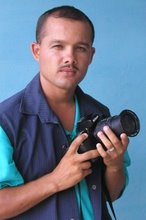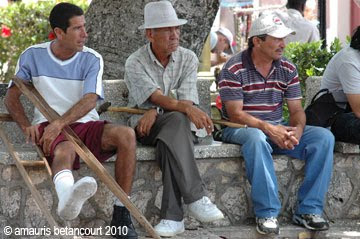
martes, 27 de abril de 2010
8vo Festival Internacional de Cine Pobre Humberto Solás: el oceo.

8vo Festival Internacional de Cine Pobre Humberto Solás: artes invitadas.
8th Low Budget Film Festival Humberto Solás: Main Characters
martes, 20 de abril de 2010
Low-Budget Film Festival Blessed with Concert by Kelvis Ochoa
Translation: Juan Carlos Dominguez Taño.

The popular Cuban musician Kelvis Ochoa played at the opening concert of the 8th Humberto Solas International Low-Budget Film Festival, held at the Da Silva Plaza in the city of  Prior to the concert, the traditional mass parade of participants and the people in Gibara took place in the also nicknamed “
Prior to the concert, the traditional mass parade of participants and the people in Gibara took place in the also nicknamed “
The Festival has also scheduled theoretical forums, professional meetings, plastic arts exhibitions, and the presentation of movie-works contending for the prizes as well as many other attractions such as the gathering with Nelson Rodriguez, whom the current Festival edition is devoted to. Elia Solas, Sergio Benvenuto Solas and journalist Joel del 
The Da Silva Plaza will also welcome - starting this Tuesday night – the presentation of the works brought by the International Festival of the Childhood and the Youth of Madrid, Spain, due to the fact this year’s event in Gibara is dedicated to the youngest generations.
And right in that same square, singer M Alfonso will perform, as a way tom make music travel to several other places of the coastal city that bewitched Humberto Solas where he shot some of his best films.
lunes, 19 de abril de 2010
The International Low-Budget Film Festival Opens Today in Gibara
Text and photos: Amauris Betancourt. Translation: Juan Carlos Dominguez.
A press conference at the House of Culture in the Cuban eastern city of Gibara marked the opening to the 8th edition of the Humberto Solas International Gibara Low-Budget Film Festival. But the traditional official opening will start at 19:00 (Havana time) with a parade from the Culture Square to the Calixto Garcia park, right across from the Jiba movie-theater. This highly competitive event at the also nicknamed ‘White Village of the Crabs’ is the headquarters to the Movie Festival that spreads to all Eastern Cuban provinces.
This highly competitive event at the also nicknamed ‘White Village of the Crabs’ is the headquarters to the Movie Festival that spreads to all Eastern Cuban provinces.This time some 160 works coming from the United States, Chile, Spain, China and other nations, will be competing in different categories such as short movies, feature films, experimental works, rough cut project and scripts, documentaries, animation and videoart. Theoretical sessions, exhibitions and concerts are included too as part of this edition devoted to children and adolescents.
Theoretical sessions, exhibitions and concerts are included too as part of this edition devoted to children and adolescents.
A panel on drama and alternative movie, and the concerts by Kelvis Ochoa, David Blanco, Rochy and Diego Gutierrez stand out among the most expected events.
Reynaldo Gonzalez, National Prize of Literature, and Tomas Piard are among the personalities that make up the jury, along with other international figures who would make a decision on the best works presented in the competition.
The closing ceremony will close the current edition a day before the festival comes to an end next April 24 with the prize awarding gala.
Gibara's dwellers.


martes, 13 de abril de 2010
Sierra del Cristal, 80 years Protecting Nature

The Natural Park, known at present as Pico Cristal Natural Park after the name of its highest elevation (1 231 meters), hosts natural treasures in biodiversity and is a resourceful means to protect the environment.
 Hello! Welcome aboard! I'm a photojournalist for www.radioangulo.cu and FlashCUBA, a bilingual webblog about photography, aims at sharing ideas and photo works from all kinds of fields; a place to promote Cuban photography.
Hello! Welcome aboard! I'm a photojournalist for www.radioangulo.cu and FlashCUBA, a bilingual webblog about photography, aims at sharing ideas and photo works from all kinds of fields; a place to promote Cuban photography.
The Hill of the Cross and the City of Holguín
By Maylin Betancourt Verdecia.
Translation by Juan Carlos Dominguez.
There are stories that seem to be too old to always be remembered, but the need to remind them becomes a must from time to time. Then a tiny goblin called memory comes back from its trip to the past. It comes closer, filled with traditions, with a scent to roots and preceded by a mystic whisper warning, each step it makes, that "the nation that forgets its history runs the risk of getting lost."
The climbing of 458 steps serves to notice why
The truth is that a few people know the mount was baptized as the Hill of the Cross back on May 3rd, 1790, because that day Fray Francisco Antonio de Alegria climbed the Bayado Hill, as it was then called, to place a wooden cross on the top. Since then, the cross has remained there and has become a jealous guardian safeguarding the city of
And to honor that event,
Anyway, anyone coming to Holguín, nicknamed also the
martes, 6 de abril de 2010
Cuban Salsa Orchestra NG la Banda Gives a Concert in Holguín
viernes, 2 de abril de 2010
PHOTOREPORTAGES
By Maylín Betancourt Verdecia.
Photos: Amauris Betancourt.
When thinking of them I can not help bringing to mind the joy, sadness, friendship, dreams and loves its benches have warmed. The first parks –the
Today we have many more and, as in the beginning, they still are the most important urban places. They have it right to say that the one visiting Holguín for the first time gets so delighted with the parks and its rhythmically street disposition and coherent organization that they always want to come back for a visit.

























